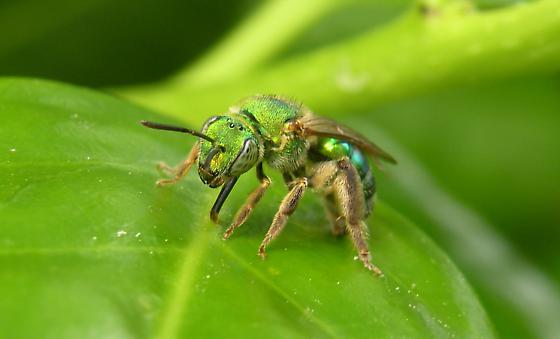An interesting brood symptom you may come across in a weak hive in the spring is Bald Brood. Bald brood is caused by the Lesser wax moth (Achroia gresella) or the Greater wax moth (Galleria mellonella.) You can see in the image below the linear pattern of uncapping that occurs due to the wax moths tunneling behavior. These symptoms can sometimes be confused as hygienic behavior; I have included an image showing some hygienic behavior of uncapping. One visible difference between hygienic behavior vs. bald brood is that there is no linear pattern of uncapping sealed brood with hygienic behavior. Colonies with bald brood often…
Month: April 2013
Know Your Local Pollinators!
Today I am posting on behalf of one of our undergrads, Tyler Connine. He is a pre-med biochemistry major at University of Maryland with a unique awareness of the natural world. Tyler is part of our ongoing Nosema project which is focused on the examination of individual bees for Nosema spores. Aside from his growing interest in honeybees, Tyler has also shown some curiosity towards native bee species. This is his blog entry. Know Your Local Pollinators! Most people are aware of the importance of pollinators in plant reproduction. But do you know about your native pollinators? The temperate climate of Maryland makes spring and summer…
Unknown Brood Damage
Posted 4/17/2013 This blog was changed from the original post. The title has changed from Pesticide brood Kill to Unknown Brood Damage. This change was in response to the comments I have received both on this blog and by emails, I want to clarify a few of my comments. First, I regret the original title of the blog as correctly noted; I had no concrete evidence that it was a pesticide brood kill. No pesticide analysis was done on the pollen or bees because, as I mentioned in the comments section, this beekeeper knew what was being sprayed, when it was being sprayed and the…
Universal Hive
The universal hive can be used to solve many everyday beekeeping challenges including how to maximize the potential and ultimately the production of a hive by means of increasing its worth through the diversification of its function. Beekeepers can be measured by their ability to act and react to an ever changing environment. They possess a working knowledge of bee biology and use experience, ingenuity, innovation, and common sense to manage their hives. Those that exercise the most applied and efficient management practices often reap the most benefits. Balancing practicality, efficiency, quantity, and quality is an art that can take a lifetime to master. An…
Potent Pollen
Dr. Zachary Huang out of Michigan State University recently wrote a review titled “Pollen nutrition affects honey bee stress resistance.” Frustratingly, it is one of those papers where you need to either pay $35 to get access to it or have access via a University library. Since it is hard to get ahold of, I am going to review it since I think the content is really interesting and important. Dr. Huang first talks about what makes a good pollen. There are two components that bees need: crude protein and 10 essential amino acids. The best pollens have over 25% protein and the complete set…
European Foulbrood (EFB) Part 2.
The most problematic pest beekeepers encounter in the United States today is the varroa mite. The varroa mite (Varroa destructor) is an ectoparasite associated with spreading disease, pathogens and reducing the lifespan of male and female honey bees. The mites accomplish this by creating wounds in honey bees with piercing/sucking mouthparts, then feeding on the hemolymph within. Research suggests that these mites transfer single-stranded RNA virus between bees, along with infections of bacteria, including Melissococcus pluton (EFB). This type of bacterial infection of larvae or pupa is considered a secondary infection, since the mite initiated the process and the bacteria followed. EFB is normally transmitted…
Gardening for Pollinators
Warm weather is just around the corner which makes this the perfect time of year to begin planting a garden. Working in the garden that has a proper stormwater management is relaxing, a great form of exercise and adds to aesthetics of your yard, plus you get lots of yummy home-grown veggies! But why stop here? Knock two birds out with one stone, and also add plants that serve as healthy food sources for honey bees, native bees and other native pollinators. The first step is selecting an ideal location for your garden if you don’t have a plot laid out already and you can…
